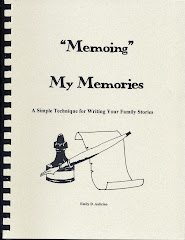Making History: How to remember, record, interpret, and share the events of your life by Kim Pearson, Primary Sources Books, an imprint of Wyatt-MacKenzie, Issaquah, WA (www.primary-sources.com). ISBN: 978-1-032279-75-7. Copyright 2007. $24.95.
I do not usually review books, but when Kim sent me a copy, when several from my writing classes were interested in it, and as her idea of writing is similar to mine, I decided to mention it in my blog.
Many books have been written on the topic of writing one’s memoir. Formerly, there were the books for grandparents which asked basic questions about their lives, then came the books with the one-line topics. The latest generation of memoir writing books encompasses the reasons for writing, various topics, and suggested leads for those topics. Ms. Pearson’s book falls within the latter.
The book begins with excerpts from her writing class and from her own experiences. Although the book may start out a bit slow for some of us who have been involved in teaching such classes, there are many interesting stories which could give the reader ideas and activate the reader’s memories.
Making History is divided into sections: Why Tell Your Stories?, How to Tell Your Stories, and How Your Stories Fit into History with several chapters for each. She explains why she wrote the book and offers her sources (mostly Web sources) and some suggested reading.
Most of us understand that writing is therapeutic, although many genealogists wish to embellish their research by going beyond the dates and places of their ancestors. Many of us write to record those family stories and childhood memories for the future generations. Ms. Pearson gives ideas on how to deal with too much information as all of us have too little time to write all we really know about our lives and those of our ancestors.
From that point, Ms. Pearson divides her book into various sections (Economics & Politics, The Social Fabric, Wars & the International Scene, Technology & Science, Crime & Disaster, Arts & Entertainment, Lifestyle Activities, and The Weird, Trivial & Hard-to-Classify) and offers a detailed timeline for each period. Timelines start in 1930 and most end in 1989 with a few ending earlier. However, the best part of her book ends each of those chapters with ideas on which people can write. Usually there are about a dozen paragraphs for each chapter like the following.
“Scan the events timelines. What sparks a memory? Is there an event listed that makes you think, ‘oh yea, I remember that’? If so, write about this event. How did you learn about it? Di you talk about it? With whom? Were you inspired to do something because of this event? Did this event change your life in any way? Change your thinking?” (p. 119)
All though the timelines are extensive, they are not, of course, all encompassing. Many of these events were probably overlooked in most of our lives, but one never knows what statement will trigger a memory. You can supplement these timelines by using the Internet, if needed.
I suggest using this book as a workbook; that is, one needs to mark it up, underlining and starring important topics and ideas as the book is read. Use post-it notes so you can return to relevant topics and suggestions.
I am pleased to see this quality of book for writing one’s memories, especially as I have used similar techniques in teaching students and know them to work. I have applied the same method of including detailed prompts in my own publication (See the icon on this blog at the right.) and would encourage any of you not to purchase any book on writing prompts unless there is more detail for each topic than just a line or two.
Emily Aulicino
© Mar 2009
Sunday, March 22, 2009
Subscribe to:
Post Comments (Atom)









No comments:
Post a Comment